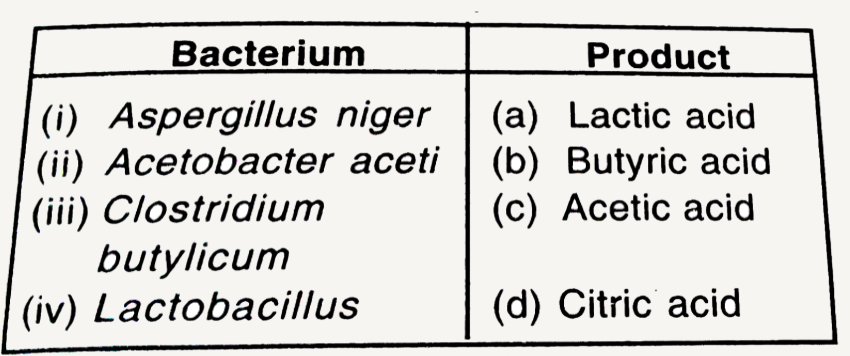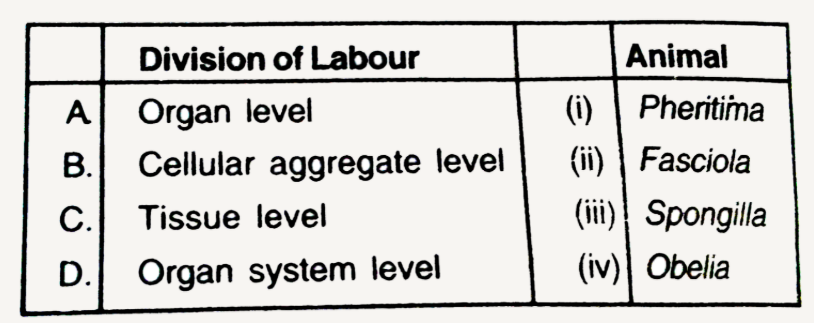Match the following lists:

The correct Answer is:a→q<b→p,c→s,d→r
(a) f(x)=sinx−x2+1
f(x)=cos x-2x

or f(x)<0forx>x0
and f(X)>0forx<x0
Hecne x=x0is the point of maxima
(b) f(X)=xlogex0−x+e−x
f(X)=logex+1−1−ex=logex−e−x

From the graph for x<x0e−x>logexorf(X)
for x>x0<logexorf(x)>0
Hence xx=x0 is point of minima
(c ) f(x)=−x3+2x2−3x+1
f(X)=−3x2+4x−3
Now D=16−4(−3)(−3)=−20<0
Hence f(x)>0 for all rel x
Thus f(x) is always decerasing
(d) f(x)=cosπx+10x3x2+x3
or f(X)=−πsinπx+10+6x+3x2
=3(x2+2x+10/3)−πsinπx
=3((x+1)2+7/3)−πsinπx
Now minimum value of 3(x+1)2+7/3 is 7 but
Maximum value of pisinπxisπ
Hence f(x)>0 for all real x
Hecne f(x) is always incresing
Topper's Solved these Questions
- MONOTONICITY AND MAXIMA MINIMA OF FUNCTIONSBOOK - CENGAGE ENGLISHCHAPTER - MONOTONICITY AND MAXIMA MINIMA OF FUNCTIONSEXERCISE - Linked comprehension type
50 Videos
- METHODS OF DIFFERENTIATIONBOOK - CENGAGE ENGLISHCHAPTER - METHODS OF DIFFERENTIATIONEXERCISE - Single Correct Answer Type
46 Videos
- MONOTONOCITY AND NAXINA-MINIMA OF FUNCTIONSBOOK - CENGAGE ENGLISHCHAPTER - MONOTONOCITY AND NAXINA-MINIMA OF FUNCTIONSEXERCISE - Comprehension Type
6 Videos
Similar Questions
Knowledge Check
Match the following list of bacteria and their commercially important products.
BacteriumProduct(i)Aspergillus niger(A)Lactic acid(ii)Acetobacter aceti(B)Butyric acid(iii)Clostridium butylicum(C)Acetic acid(iv)Lactobacillus(D)Citric acid
Choose the correct match.Ai−(B),ii−(C),iii−(D),iv−(A)Bi−(B),ii−(D),iii−(C),iv−(A)Ci−(D),ii−(C),iii−(B),iv−(A)Di−(D),ii−(A),iii−(C),−iv−(B)
Match the following list of bioactive sub- stances and their roles
Choose the correct match

View SolutionMatch the following list of bacteria and their commercially important products
Choose the correct match

View SolutionMatch the following list of animals with their level of organisation :

Choose the correct match showing division of labour with animals.
View SolutionMatch the following list of animals with their level of organisation.
Choose the correct match sryowing division of labour with animal example.

View SolutionMatch the following list of animals with their level of organisation.
Division of LabourAnimalA.Organ leveli.PheretimaB.Cellular aggregate levelii.FasciolaC.Tissue leveliii.SpongillaD.Organ system leveliv.Obelia
Choose the correct match showing division of labour with animal example.
View SolutionMatch the following list of bioactive substances and their roles.
Bioactive substanceRole(i)Statin(A)Removal of oil stains(ii)CyclosporinA(B)Removal of clots from blood vessels(iii)Streptokinase(C)Lowering of blood cholesterol(iv)Lipase(D)Immuno-suppressive agent
Choose the correct match.
View SolutionMatch the following list of bacteria and their commercially important products.
BacteriumProduct(i)Aspergillus niger(A)Lactic acid(ii)Acetobacter aceti(B)Butyric acid(iii)Clostridium butylicum(C)Acetic acid(iv)Lactobacillus(D)Citric acid
Choose the correct match.
View Solution

